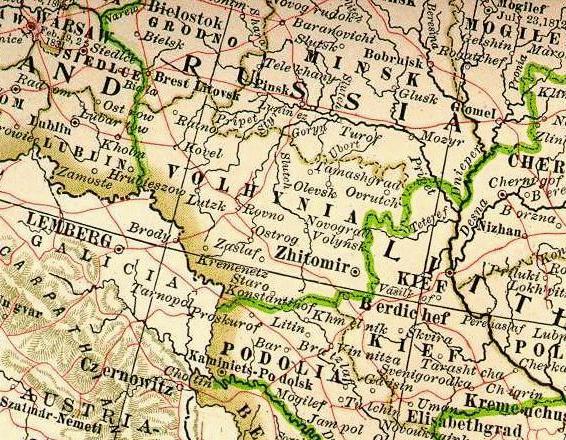|
|||
|
Sudilkov was located at 27.80 longitude and 50.10 latitude at an altitude of 813 feet, in the present Ukrainian oblast (district) of Khmelnitsky. During much of the eighteenth century the town actually lay within the territory of Poland, but this changed with the Russian annexation of a huge chunk of that country in 1793 (Prussia and Austria grabbed the remainder). From then until 1919, it was situated in Volhynia Gubernia, one of several czarist-era provinces constituting the western extreme of the Russian Empire.
Volhynia
Location of Sudilkov in Volhynia The historical province of Volhynia Gubernia was also known as Volinskaya, Wolin, Wolyn, Wolina, Wolinsk, Volinski, Wolinski, Volenskii, Wolenskj, Wolenskja, Volin, and Volyn, depending on which language or dialect you spoke. For our purposes I will use only the Russian form. In the Middle Ages Volhynia was an autonomous duchy. Its existence is attested to by maps which date back to the tenth century. The 15th edition (1980) of the Encyclopædia Britannica states that Volhynia “was a Russian principality (10th-14th century) and then an autonomous component of the Grand Duchy of Lithuania. The region became prominent during the 12th century, when many emigrants from the declining Kiev principality settled in Volhynia and its even more westerly neighbor Galicia. In 1199 Prince Roman Mstislavich of Volyhnia (died 1205) united the two territories into a powerful principality, which dominated Kiev; successfully battled the Poles, Lithuanians, Hungarians and Polovtsy (or Cumans); and was sought as an ally by Byzantium. Roman’s son Daniel (reigned 1221-1264) reunited Volhynia with Galicia in 1238 (the union had lapsed after Roman’s death), built cities (e.g. Lvov), encouraged a flourishing east-west trade through his lands, and fostered the development of the fine arts. In 1260, however, Volhynia and Galicia were devastated by a Mongol invasion and forced to recognize the Mongol khan as their overlord. “In the course of the 14th century, Volhynia was absorbed by the Lithuanian state, [while Galicia was absorbed by Poland]. After the Polish-Lithuanian union of 1569, Volhynia was ceded to [the latter]. It remained a Polish territory until the second partition of Poland (1793) transferred most of it to Russia. After World War I it was divided between the Soviet territories and Poland.” Thus, Sudilkov reverted to Polish rule along with the western half of the former gubernia. In the aftermath of World War II the entire region was absorbed into the Ukrainian S.S.R. and divided into three oblasti, Volyn, Rovno and Zhitomer. At the time of its destruction in 1941 Sudilkov was a small town in the middle of the Ukrainian Soviet Socialist Republic. Today, what was once Volhynia Gubernia lies in the western part of the Ukraine, with the exception of a small portion of northern Volhynia which is in Belarus. The present Ukrainian region of Volhynia, located in the basin of Pripyat and the western Bug, is smaller than its czarist ancestor. It covers an area of 20,200 square kilometers and has a population of approximately 1.1 million inhabitants. Major cities and towns in and around Volhynia include Zhitomir (the former capital, pop. 30,000), Rovno (pop. 21,700), Lutsk, Kovel, Berdichev, and Novograd-Volinsk. The region is known for the great beauty of its countryside. Tourists and locals often visit Shhatskiy National Park, which is still much covered by virgin forest. In addition, Volhynia boasts over 220 lakes, the largest of which are Svitazh, Pulmo and Lukye, and about 3,000 kilometers of rivers. According to the Catholic Encyclopedia (See the section on the Diocese of Lutzk, Zhitomer and Kamenetz), Volhynia was at one time entirely of the Greek Orthodox Rite, “but with the conquest of Volhynia and Podolia by the Lithuanians in 1320, and the later conquest and union of Lithuania by the Poles in 1569, the Latin Rite became well established, and accordingly Latin bishoprics were founded.” The diocese of Lutzk was the most important, and its jurisdiction once included the whole of Volhynia. However, with the Second Partition of Poland in 1793, the Latin dioceses were suppressed and the Catholic Church was forever consigned to the margins of society. As I stated above, the Jews constituted a significant proportion of the inhabitants of the region (including Volhynia), especially while it formed part of the Pale of Settlement. According to the “Evreiskaia (Jewish) Entsiklopedia”, published in St. Petersburg in 1907-1913, in 1897 there were 182,833 Jews in Volhynia out of 358,459, a total of 51% of the population. Volhynia was home to some of the most intense Jewish intellectual and spiritual activity, not only in the Russian Empire, but in the entire world. In 1900 two large publishing houses in Zhitomer produced nearly one-half of all the Hebrew books printed in Russia (Encyclopedia Brittanica, 1900 edition). For more information on the Jews of Volhynia, I recommend the following books: Sophia Kossak, The Blaze: Reminiscences of Volhynia, 1917-1919 (George Allen & Unwin Ltd., London, 1927); Shmuel Spector, The Holocaust of Volhynian Jews, 1941-1944, trans. by Jerzy Michalowicz (library material DS135.S72 U52 VOL S64 1990); Nathan Hanover, Abyss of Despair (Yeven Metzulah), trans. by Abraham J. Mesch, Transaction Books, New Brunswick, NJ, 1983); Isaac Babel, Diary, ed. Carol J. Avins, trans. by H.T. Willetts, Yale University Press, New Haven & London, 1995; Shmarya Levin, Childhood in Exile, Harcourt, Brace and Company, Inc., New York: 1929, reprinted Arno Press Inc., New York, 1975. |

